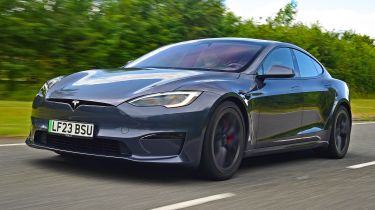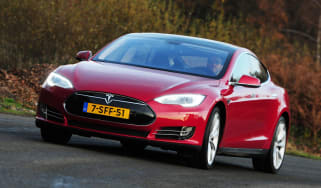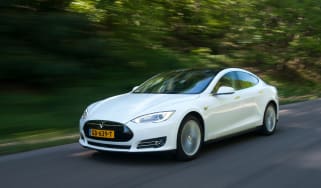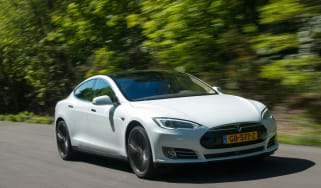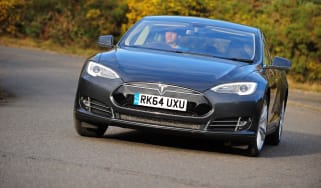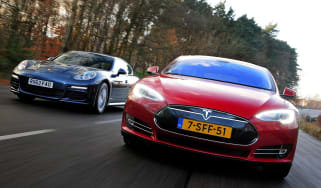Tesla Model S review
The all-electric Tesla Model S is more impressive than ever, but it’s left-hand drive only and new rivals mean it’s got a fight on its hands

The Tesla Model S is finally back on sale in the UK, and it’s better than ever. The updated version of Tesla’s premium all-electric saloon has a huge driving range, features simply excellent technology and is hugely practical. The standard dual-motor version will be powerful enough for most drivers, but the fabled straight-line performance of the Model S Plaid has an undeniable allure and will entice more than a few buyers.
Even the far-from-perfect build quality of earlier examples is vastly improved and Tesla has made the controversial steering yoke optional – hallelujah! However there’s an even bigger caveat potential buyers will have to wrestle with: the Model S is now left-hand drive only. We know Tesla likes to do things its own way a lot of the time, but we expect driving on the wrong side of the car will be a dealbreaker for potential UK buyers.
About the Tesla Model S
A combination of searing performance, slippery looks and a cool, high-tech, minimalist cabin dominated by a big central touchscreen has proved highly attractive to buyers around the world for the best part of a decade, making the Tesla Model S the undisputed leader in Electric Vehicle (EV) luxury.
At least it did, until the mainstream auto industry started to catch up, and now buyers have the choice of tantalising EV rivals that include other executive saloons such as the Mercedes EQE and Genesis Electrified G80, sportier and more engaging alternatives such as the Porsche Taycan and Audi e-tron GT, and more luxurious limousines including the Mercedes EQS and BMW i7 – our Luxury Car of the Year for 2023.
Used - available now

2013 Tesla
Model S
171,300 milesAutomaticElectric
Cash £10,495
2016 Tesla
Model S
49,453 milesAutomaticElectric
Cash £16,680
2016 Tesla
Model S
84,209 milesAutomaticElectric
Cash £13,700
2013 Tesla
Model S
101,499 milesAutomaticElectric
Cash £13,495The new Lucid Air poses even more of a challenge to the Model S. It’s not available to buy in the UK just yet, but the Lucid’s comfortable ride, hugely spacious and luxurious cabin, spectacular performance and jaw-dropping looks suggest the once-novel Tesla may be running out of time as the leader of the premium EV pack.
That said, the Tesla Model S is the car that helped to make EV ownership desirable, which paved the way for cars like the Air, Taycan and e-tron GT. In terms of size, the Model S falls into the executive sector, but while the five-door hatchback body is fairly conventional, it beats many rivals on practicality, thanks to the compact packaging of the electric-drive system. There's also extra luggage space under the bonnet where an engine would normally reside.
Constant updates to the Model S mean the current range is quite different compared to when the car was launched. There was a facelift in 2016 where the nose lost its fake grille, and brought the Model S into line with the Model X seven-seat SUV, while the updated version that arrived in the UK in 2023 introduced far more significant changes.
Tesla used to give different versions of the Model S a number to identify them. In the past this has included 60, 60D, 70, 70D, 75, 75D, 85, 85D, P85+, P85D, 90, 90D, P90, 100D and P100D versions. The numbers signified the kWh (kilowatt-hour) rating of the lithium-ion battery pack, with a larger number signifying more power and greater range. The D identifier meant dual-motor, so was applied to the four-wheel-drive variants.
The lineup is a lot simpler now, with just two versions available: the ‘standard’ dual-motor Model S which has a claimed range of 394 miles and produces a very generous 661bhp. Meanwhile, the Model S Plaid uses three electric motors – two on the rear axle, one for the front – with a combined 1,006bhp that allows it go from 0-60mph in less than two seconds, according to Tesla. The maximum range is equally formidable, with up to 373 miles possible on a single charge.
You can spot the updated Model S version by its new front bumper, while the Plaid gets extra aero tweaks with a lower front splitter, revised rear diffuser and a subtle spoiler on the boot lid. The more obvious changes are inside, where you’ll find a new and even more minimalist cabin design, which is available with either a traditional round steering wheel or an aeroplane-style steering yoke. The original Model S’s portrait-orientated touchscreen has also been replaced by a 17-inch landscape display.
Aside from the steering yoke, the most controversial feature on the Model S is Tesla's Autopilot. It's at the cutting edge of autonomous driving technology, but the name is a little misleading, because the driver cannot hand over complete control of the car to the electronics. However, it does allow for an element of 'hands-free' driving, on the motorway especially, although the driver does need to maintain concentration on the road ahead in case the electronics miss something. Latest Autopilot versions include the ‘Summon’ feature which allows owners to direct their car short distances to their location using Tesla’s app, and the self-parking feature has been upgraded.
Electric motor, drive and performance
It couldn’t be any simpler to drive a Model S: there’s no handbrake or starter button, because sensors detect when you're sitting in the car and turn it on. The updated Model S moves things on even closer towards full autonomy, because the gearshift stalk has been deleted altogether and the Model S software decides which direction you want to drive in, although you can override its decision via the touchscreen or a row of buttons on the centre console.
Driving on the left isn’t as big a problem as you might expect, because the plethora of radar sensors, cameras and safety systems let you know if there are any cars, bikes or pedestrians in your blind spot via the high-definition instrument cluster. Entering car parks and dealing with toll booths is a bit of a faff, though.
Give the throttle a gentle touch and the car responds instantly. All versions of the Model S have four-wheel drive and have plenty of traction. And when you're taking it easy, the Model S can cruise comfortably at motorway speeds. It’s not as quiet as a BMW i7 mind you, and you hear the whirr of the electric motor, as well as some roar from the tyres and wind, but it’s still a calmer environment than in a typical petrol or diesel car. The Tesla also comes loaded with kit that can help take the stress out of long journeys, and the firm’s Autopilot remains one of the smoothest and most advanced set-ups of its type.
Yet while the rapid acceleration will make you smile, any spirited driving will eat into your range. With a full charge, Tesla claims a range of close to 400 miles for its latest versions, but whatever your driving style the car’s energy flow data always keeps you fully informed, limiting range anxiety a little.
We’ve yet to drive the standard dual-motor Model S in the UK, but we have tested the range-topping Model S Plaid on British roads. Our test car rode on the optional 21-inch Arachnid wheels, wrapped in super-grippy Michelin Pilot Sport 4S tyres. The sticky rubber gives the Model S gives the Model S terrific amounts of traction on both straight and winding roads, regardless of how much power you put down.
It’s poised when cornering, too, with very little body roll, though the steering lacks feel in all three of its settings, with Sport mode simply adding more weight. The much sportier Porsche Taycan is the more engaging and enjoyable car to drive, with the driving experience in the Model S more akin to a rollercoaster: you strap in and hold on. Unfortunately, the Plaid doesn’t get particularly supportive seats, so it feels as if you’re being thrown about quite a bit on twistier roads.
When you’re not attempting to break the sound barrier, the Model S still does the mundane stuff perfectly well. Switch the powertrain into Chill mode and the throttle response is dulled, plus there’s Comfort mode for the steering and suspension – which is how we expect most Model S owners will set up their cars, until they wish to flaunt its straight-line performance.
Every Model S features adaptive air suspension so it rides well and you can vary the ride height. A 'Low' setting is designed to offer the car even better high-speed aerodynamics to maximise the car's range, while the default ‘Medium’ height is meant to provide a balance between comfort and handling. The ‘High’ and ‘Very High’ are best reserved for speed bumps, steep driveways and other obstacles.
0-62mph acceleration and top speed
Tesla doesn’t release 0-62mph times for its cars. Instead, it states 0-60mph times, with the standard dual-motor Model S capable of hitting 60mph from a standstill in 3.1 seconds. That’s quick enough to show most supercars a clean pair of heels at the traffic lights, but hardly surprising when you consider it produces 661bhp. It has a top speed of 155mph.
If you fancy embarrassing some hypercar owners instead, then it’s the Plaid version you’ll be wanting. The tri-motor Model S pumps out 1,006bhp and a scarcely believable 1,420Nm of torque, all of which is available in an instant. The 0-60mph sprint takes just 1.99 seconds according to Tesla, although one slight caveat is that it excludes the initial rollout off the line, but the difference would be a few milliseconds at most. The Model S Plaid also gets a higher top speed of 200mph.
For a time, Tesla CEO Elon Musk said the firm would actually produce an even faster version of the Model S called the Plaid+, but it was cancelled.
Yet launching from a standstill isn’t when the Model S Plaid feels fastest; it’s even more addictive watching slower moving traffic disappear in your rear-view mirror as you hit the motorway. There’s no need to plan for overtakes either; you simply see a gap and seize it.
Range, charging and running costs
Despite the advancements in battery technology and electric motors becoming more efficient, range is still a big concern for many potential first-time EV buyers. However, we don’t expect Model S drivers will suffer from range anxiety all that often when it can cover close to 400 miles on a single charge, and benefits from access to Tesla’s Supercharger network.
The standard dual-motor Model S has an official WLTP range of 394 miles – one of the longest offered by any electric car currently sold in the UK. Unsurprisingly, the super-fast, tri-motor Model S Plaid won’t go quite as far on a charge, but its 373-mile range is still impressive. Use the Plaid’s insane performance at every available opportunity and you’ll struggle to achieve its claimed range, however.
The Model S has a maximum charging speed of 250kW, which sits between the Mercedes EQS’s 200kW v-max and 270kW Porsche Taycan and Audi e-tron GT. Regardless, if you use one of the latest V3 Tesla Superchargers, a 10-80 per cent top-up should take just 30 minutes.
When it comes to charging at home, it will take more than 13 hours to fully recharge the Model S using a typical 7.4kW home wallbox. If your house has three-phase power, you can install an 11kW home charger and that’ll cut that time down to roughly 10 hours.
Starting at over £100,000, the Model S is not a cheap car to buy, but like all electric cars it’s exempt from road tax (VED), the London Congestion Charge and other emissions-based fees. Also, because there’s no tailpipe emissions, the Model S attracts one of the lowest Benefit-in-Kind (BiK) tax ratings, so it’s particularly appealing for company car drivers.
Insurance groups
The Tesla Model S occupies the highest group 50, which is hardly surprising considering it’s an expensive and extremely fast electric saloon from a company that has a less than stellar reputation for build quality. So be prepared for some pretty hefty insurance quotes.
Check if your car needs an MoT and view its complete history with our MoT History Checker...
Depreciation
Our latest expert data indicates that the updated Tesla Model S will retain about 50 per cent of its original value after three years and 36,000 miles of motoring. In comparison, the Porsche Taycan saloon will hold onto 57 per cent of its list price after the same ownership period, although that depends on the exact model, while the Mercedes EQE is expected to retain close to 53 per cent of its value on average.
To get an accurate valuation on a specific model check out our free car valuation tool...
Interior, design and technology
The styling of the Model S has slowly evolved over the past decade-and-a-bit it's been around, but its low-slung and svelte shape hasn’t changed and it’s not a bad-looking car. Its wide haunches and sweeping roofline help give it a sporty stance on the road, especially when combined with the optional 21-inch alloy wheels. Plaid models receive some upgraded bodywork, rear diffuser, carbon-fibre bootlid spoiler and unique badging.
However, it’s inside that Tesla’s different approach hits home, and it’s even more emphatic in the latest model with its all-new interior. Pull on the pop-out door handles and the first thing you’ll probably notice is the enormous 17-inch touchscreen in the centre of the dash, followed by hardly any buttons. The few left are a gear selector and a hazard warning switch located below the wireless charging pad.
The Model S also gets a TFT screen in the instrument cluster pod set in front of the driver, plus a screen for the rear passengers to control the temperature in the back. In terms of entertainment, it might not feature anything like Mercedes’ ‘Hyperscreen’ infotainment set-up, or the BMW i7’s 31-inch 8K Theatre Screen, but the Model S can stream movies and TV shows on Netflix (only when you’re parked, mind you) and has plenty of games to choose from in the ‘arcade’. There’s the Tesla’s toy box too, which includes ‘emissions’ and ‘romance’ modes.
Only Tesla could stir up controversy about a steering wheel, but it managed to do just that after the updated Model S launched exclusively with a steering yoke. It’s a feature that’s starting to show up more and more in new EVs, including the Lexus RZ SUV and MG Cyberster two-seater, however Tesla now gives buyers a choice of the yoke or a conventional round steering wheel.
You still don’t get any physical buttons on either, just two scroll wheels for adjusting the volume, and touch-sensitive panels to control the wipers and lights. Even the indicator switches are now on the steering wheel, which don’t do the user experience any favours.
Build quality was never the Model S’s strong suit, in fact it has long been one of the car’s biggest failings. Thankfully Tesla has taken some very welcome steps in the right direction, and we found most of what you touch inside seems worthy of this car’s circa-£100,000 price tag, although the cutting-edge tech and awe-inspiring speeds also helps with that. Admittedly, some of the external panel gaps are still a bit large for our liking, but it’s better than it used to be.
You can’t custom order a new Tesla Model S (or Model X) in the UK at the moment. Instead you pick from the available inventory of new cars, although there are plenty to choose from, all ready to be delivered. There’s not a huge options list to choose from with the Model S, just five exterior paint colours and three interior colour schemes: black, white and cream. As well as the choice of steering wheels and standard or Plaid models, buyers can also add Tesla’s full Autopilot system.
Standard kit includes the three aforementioned screens, a 22-speaker, 960-watt sound system with Active Road Noise Reduction, 19-inch alloy wheels, wireless charging pads in the front and back and a suite of driver assistance tech.
Sat-nav, stereo and infotainment
The Tesla Model S set a new benchmark for interior technology when it first launched, and the updated model is even better. The big change is the new 17-inch central touchscreen, which is now landscape rather than portrait, can be tilted more towards the driver or front passenger, and is as sharp and precise as an iPad. There’s no Apple CarPlay or Android Auto, but you can download some apps straight to the car that give you access to services such as Spotify on the go.
Tesla also uses Google Maps for its sat-nav, so it’s familiar and easy to use. You either follow instructions on the touchscreen or have them displayed within the high-definition instrument panel. Speaking of which, you get information about whether you have cars, bikes and even pedestrians in your blind spot via the driver’s display.
But the touchscreen is responsible for so much more than your navigation and music – you rely on it for almost all of the car’s main functions, including the lights and wipers, with the latter buried within the car’s menus. Thankfully Tesla’s system features big icons and a relatively logical layout eases some of our frustrations.
Practicality, comfort and boot space
With no engine to find space for, and the batteries and the electric motor mounted low in the car, the Model S is a very practical executive saloon. Its sleek hatchback body provides generous accommodation for five. Meanwhile, its compliant ride and silent-running refinement make it a genuinely satisfying and relaxing mode of transport. Access to Tesla’s Supercharger network and the Model S’s huge range also help take the stress out of long motorway journeys, while wireless charging pads in the front and rear mean everyone can keep their smartphone topped up.
One caveat is the Model S being left-hand drive. That might not be a problem on the motorway, but consider what you’re going to do when you want to enter a multi-storey car park and the ticket machine is on the other side of the car. Tesla’s rather extraordinary solution is to provide all UK buyers with what it calls the ‘Reacher’, or a black plastic litter picker to everyone else.
Dimensions and size
The Tesla Model S is 5,021mm long, which means it's roughly the same length as a BMW 5 Series or Porsche Panamera. The Model S also measures 1,987mm wide (excluding door mirrors) and stands at 1,431mm tall when the air suspension is in the default 'Medium' setting.
Leg room, head room & passenger space
There’s plenty of space inside; enough we reckon to fit three medium-sized adults across the rear bench. In the back, there’s plenty of legroom and no transmission tunnel to eat up space for the middle-seat passenger. All cars get a full length panoramic roof, but headroom is fine for all but the very tallest adults. The Model S also features three sets of ISOFIX mountings in the rear, rather than the usual set-up of two in the back and one on the front passenger seat.
Boot space
The Model S’s boot is a pretty cavernous 709 litres, and there’s not much of a load lip to contend with, which is good when you’ve got to handle heavier items. Drop the rear seats and the luggage capacity grows to 1,739 litres or enough space for a bicycle, although we found that the rear seats don’t fold completely flat. This being a Tesla, you also get an extra 89 litres of storage space under the bonnet which is handy for storing the charging cables, although it has to be opened via the main infotainment display.
Towing
The Tesla Model S has a maximum towing capacity of 1,600kg and comes with a Trailer Mode that adjusts how some of the safety features such as cruise control behave.
Reliability and safety
The Model S has been crash-tested by industry experts Euro NCAP twice: once in 2014, then again in 2022, and received the maximum five-star safety rating both times. Following the most recent round of testing, the Model S scored a 94 per cent for the adult occupant protection, 91 per cent for child occupant protection and a near-flawless 98 per cent in the safety assistance technology category.
While Tesla has weathered various media storms around its Autopilot system, which has been implicated in a handful of serious accidents sometimes attributed to driver inattention, it's still one of the smoothest and most advanced set-ups of its type.
Build quality was previously one of the Model S’s biggest failings, but the updated model has made some big steps in the right direction, particularly in the cabin. However, some of the external panel gaps on the Model S we drove were quite large, so there's still work to be done.
Tesla is also committed to continually updating the software installed on all its vehicles. As well as routinely upgrading the performance of autonomous driving and safety systems, it’s also possible to effect ‘repairs’ over the air. For example in mid-2017, Tesla issued an over-the-air fix for a potential airbag fault, which would otherwise have prompted a nationwide recall notice.
The Tesla Model S didn’t make it onto our list of the best cars to own based on the results of the 2023 Driver Power owner satisfaction survey, and neither did its SUV counterpart, the Model X. However, Tesla as a brand performed much better in the survey, and managed to finish third in our best car manufacturer rankings – behind Polestar and Porsche. Owners weren’t particularly pleased with their cars’ fit and finish or ride quality, but had plenty of praise when it came to performance, running costs, safety features and infotainment.
Warranty
All Teslas, including the Model S, are covered by a four-year/50,000-mile warranty, which is a reasonably long time but the mileage limit is less generous, especially if you plan to make full use of electric saloon’s huge range on lengthy journeys.
The Model S also comes with a battery and drive unit warranty lasting eight years or 150,000 miles (whichever comes first), with a minimum 70 per cent retention of battery capacity over the warranty period. It's transferable between owners, too, even if you never service the car.
Servicing
When it comes to maintenance, Tesla simply says “your vehicle should generally be serviced on an as-needed basis”. But it does recommend you get the Model S’s brake fluid checked every two years, and the cabin air filter should be replaced after three years, among other small tasks.
You can schedule a service via the Tesla app and, at the time of writing, Tesla has 33 Service Centres in the UK.
